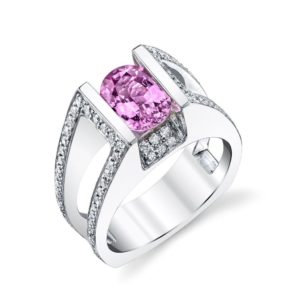When most people inquire about the grading classification of a sapphire, they expect that it will have a similar standardized system as diamond grading. Standardized grading of color, clarity and cutting has never been something that has been established on a uniform basis within the trade or within the various independent gemological laboratories. There are many legitimate reasons why this is the case.
The basis is this: There are too many unique variables and subjective gradings within the realm of colored stones. Diamonds for example, are not graded on tone, saturation or type of color – they are graded on the basis of not having any color. The baseline is colorless in diamonds. The diamond laboratories now use computer equipment that will electronically grade diamond color content against a baseline of colorlessness. You can’t do this with sapphires and other colored gemstones.
Colored stones are all about many characteristics of color:
– Color tone
– Saturation
– Purity of color
The problem is that color interpretation is always unique from one person to the next, so it is almost impossible to agree on a standard. Also, there are so many tones and hues of one type of color that identifying them all correctly on a standardized basis would be impossible.
On clarity, colored stones are generally far more saturated with inclusions at a level of 10 x magnifications than with diamonds. There are many different types of inclusions in colored stones as well. If the same clarity grading system were in place for colored stones as it is for diamonds, there would almost never be high-clarity graded colored gemstones.
This does not mean that all colored stones are included; rarely can you see inclusions without the support of magnification. Even in “included” colored stones it is difficult to see clarity issues without close inspection or with the aid of a loupe or microscope.
Cutting grading has similar complexity issues as clarity grading. The basic issue with grading cutting on colored gemstones is that there are so many types of cutting styles. It would be almost impossible to give a complete detail of a cutting style on each and every colored stone.
Demand for laboratory grading within sapphires and other colored stones has not reached a level where such a standardized system has been needed as of yet. If demand continues to rise for a standardized grading system it is possible that some perimeters will be established in a uniform code. In most cases an ideal grading should be done by a third party that has excellent experience within the field as well as no interest in the sale of the item being graded. But the bottom line is that there is currently no standardized grading system. If someone tells you otherwise they are trying to sell you a service that is only reliable with that one person or company and not the general market.
What matters most in the end is how the sapphire appears to you. Below are the main points you want to review for “grading.”
Color
It must be pleasing to your eye. Whether it be blue, pink, yellow, Padparadscha, or unique sapphire colors, this is the first priority in purchasing a sapphire. Color is subjective, but usually on beautiful things most people agree. Something with a good purity of color that shows well in all lighting conditions is what will usually be in high demand, and hence cost more than a sapphire with mixed color tones.
Treatments
Treated sapphires cost MUCH less than stones that are untreated (they should if you are buying from a reputable source). At The Natural Sapphire Company we only try to offer 100% untreated sapphires. There are so many different types of treated sapphires. If you would like to learn more about the many types of treatments please refer to the Before and After Photos.
Clarity
If you can see inclusions within the sapphire easily this will bring the value down. If you can’t see anything at all within the stone then this will be very rare, as sapphires will almost always have some internal visual inclusions.
Cutting
Full light and color reflection is a very important part of a fine sapphire. A “window” is a term used when the center of the stone is lifeless and has no color or light reflection. A “window” will allow you to see through the backside of the sapphire. Large windows should bring the price down in a sapphire, while a stone with no window and full color and light reflection should increase the price. Faceting a sapphire takes great talent and care. It takes decades to master this rare skill. A beautiful cut transforms the rough crystal into an extremely fine stone.
Window: an area in a transparent gemstone where the body color appears to be see-through or watery. This occurs when the crown or pavilion angles are cut shallowly, causing light to leak out of the pavilion.
Brilliance: the amount of light that a cut gemstone reflects back to the viewer from the interior of the stone. Brilliance is a consequence of cut and it is an important characteristic because it determines the perceived liveliness and color of a gemstone.
Extinction: an area of a transparent gemstone where the body color looks very dark to black. This occurs when gemstones are cut with excessively deep pavilions.
Zoning
Zoning, or sometimes referred to as “color-zoning” is when the color intensity or color purity is not uniform throughout the sapphire. If you can see more color on one side but less on another side of a stone this should decrease the price.
Size
The size of a sapphire will have a good amount of influence over its price vs. a smaller stone of similar attributes.
1-2 carat sapphires in fine quality are quite rare. Medium to lower qualities are not very uncommon.
3-4 carat sapphires in fine quality are difficult to replace. Medium to lower qualities are available but not in large quantities.
5-7 carat sapphires in fine quality are very rare and almost impossible to match or replace. Medium to lower qualities are rare in this size as well.
8-10 carat sapphires in fine quality are one of a kind, no two stones are the same, reliable supply is not possible to maintain. Medium to lower qualities are rare and difficult to obtain as well.
10+ carat sapphires in fine quality are usually referred to as “Important” as they are always one of a kind, extremely expensive in blue, pink and rare colors. These stones are for the lucky and fortunate, not just the wealthy. Just to see these types of sapphires in person is referred to as a privilege.
Origin
The origin of a sapphire can have significant value determination. Sapphires have historical references in history and culture from particular locations that can weigh heavily on their values today. Burmese and Ceylon (Sri Lankan) sapphires have been characterized as fine sapphires in Europe for centuries, but Kashmir sapphires now have elite status, as they are no longer being found or mined.
Source: The Natural Sapphire Company; Sapphire rings and necklace: Jewelry by Gauthier


